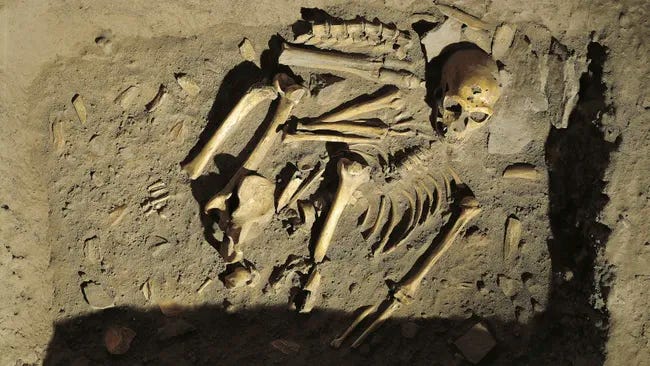Diverging Paths of Mourning: Burial Practices of Neanderthals and Early Homo sapiens
Manage episode 451539996 series 3444207
Neanderthals and early Homo sapiens, two of the closest relatives in the human evolutionary story, share a unique distinction: they are the only known hominins to have buried their dead. However, a recent study1 has uncovered notable differences in how these ancient groups honored their deceased, shedding new light on the cultural and social evolution of early humans.
The Study: Insights from Ancient Burials
Researchers from Tel Aviv University and the University of Haifa conducted an extensive analysis of 32 burials: 17 attributed to Neanderthals and 15 to early H. sapiens. These burials, ranging from 35,000 to 120,000 years ago, were discovered in Western Asia, a region both groups inhabited simultaneously.

Shared Practices
The study identified several shared features between Neanderthal and early H. sapiens burials:
“They both buried males and females, and babies, children, and older people,” noted Ella Been, the study's lead author.
Both groups also interred grave goods with their dead, a practice reflecting symbolic thought. Neanderthal burials included items such as wild goat horns, red deer jaws, tortoiseshells, and stone artifacts, while early H. sapiens included deer antlers, boar jaws, seashells, and ochre.
Distinct Burial Traditions
Despite these similarities, the study revealed stark differences in burial customs.
Location of Burials:
Neanderthals typically buried their dead inside caves, under roofs, while early H. sapiens buried theirs outside caves or near cave entrances.Body Positions:
Early H. sapiens often buried their dead in the fetal position, with heads tucked toward the chest. In contrast, Neanderthals used a variety of positions in their burials.
Cultural Implications
John Hawks, a paleoanthropologist from the University of Wisconsin–Madison, highlighted the significance of these findings:
“There appear to have been consistent burial practices that distinguished Neanderthal and early H. sapiens burials,” he stated. “This is surprising because all of these small, scattered populations wouldn’t be expected to share cultural practices over long stretches of space and time.”
The study suggests that these burial practices emerged independently but around the same time—between 90,000 and 120,000 years ago—in the Levant, a region encompassing modern-day Israel, Jordan, Lebanon, and Syria.
The Levant: A Cultural Crossroads
The Levant has long been considered a critical gateway for hominin migration out of Africa. The discovery that both Neanderthals and early H. sapiens began burying their dead in this region strengthens theories of cultural exchange between the two groups.
“Previous work suggested that Neanderthals and early H. sapiens exchanged knowledge in the Levant,” Been explained. “If you look at sites with overlapping timeframes, the artifacts alone would not indicate whether they were Neanderthal or H. sapiens.”
Burials as Territorial Markers
The researchers propose that burials may have served more than a symbolic purpose. They suggest that competition for resources in densely populated regions could have driven both groups to use burials as a way to establish territorial claims.
“When groups share the same territory, they may use burials to mark their connection to specific caves,” Been theorized.
Ongoing Questions
Despite these intriguing insights, the study acknowledges limitations. The small sample size of burials leaves room for alternative interpretations.
“The question is whether there is transmission of ideas or concepts from one single source,” Hawks noted. “The data are not sufficient to demonstrate that flow of information.”
Ella Been agreed, emphasizing the need for more excavation and research:
“Maybe in three years, or 30, or 300, we’ll find more burials, and the implications will change.”
Conclusion
While the study of Neanderthal and early Homo sapiens burials offers a glimpse into their shared humanity and divergent cultural paths, it also raises profound questions about the origins of symbolic thought and cultural exchange. These burial practices, whether driven by social, symbolic, or territorial motivations, underscore the complexity of our evolutionary cousins and the enduring mysteries of their lives and deaths.
Been, E., & Barzilai, O. (2024). Neandertal burial practices in Western Asia: How different are they from those of the early Homo sapiens? L’ Anthropologie, 128(3), 103281. https://doi.org/10.1016/j.anthro.2024.103281
9 ตอน




